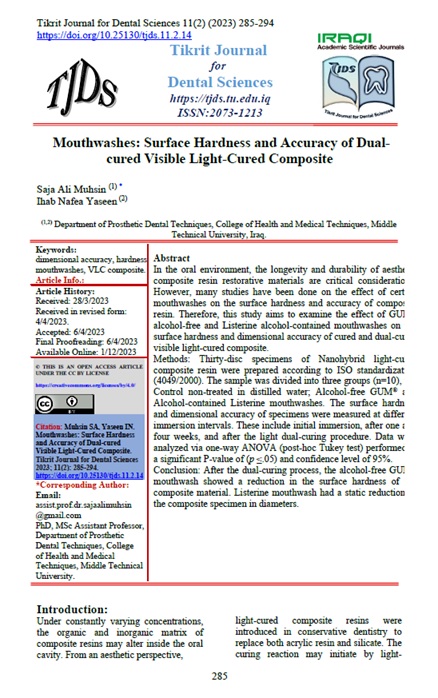Mouthwashes: Surface Hardness and Accuracy of Dual-cured Visible Light-Cured Composite
Saja Ali Muhsin
Department of Prosthetic Dental Techniques, College of Health and Medical Techniques, Middle Technical University, Iraq
Ihab Nafea Yaseen
Department of Prosthetic Dental Techniques, College of Health and Medical Techniques, Middle Technical University, Iraq
DOI: https://doi.org/10.25130/tjds.11.2.14
Keywords: dimensional accuracy, hardness, mouthwashes, VLC composite
Abstract
In the oral environment, the longevity and durability of aesthetic composite resin restorative materials are critical considerations. However, many studies have been done on the effect of certain mouthwashes on the surface hardness and accuracy of composite resin. Therefore, this study aims to examine the effect of GUM® alcohol-free and Listerine alcohol-contained mouthwashes on the surface hardness and dimensional accuracy of cured and dual-cured visible light-cured composite.
Methods: Thirty-disc specimens of Nanohybrid light-cured composite resin were prepared according to ISO standardization (4049/2000). The sample was divided into three groups (n=10), the Control non-treated in distilled water; Alcohol-free GUM® and Alcohol-contained Listerine mouthwashes. The surface hardness and dimensional accuracy of specimens were measured at different immersion intervals. These include initial immersion, after one and four weeks, and after the light dual-curing procedure. Data were analyzed via one-way ANOVA (post-hoc Tukey test) performed at a significant P-value of (p ≤.05) and confidence level of 95%.
Conclusion: After the dual-curing process, the alcohol-free GUM® mouthwash showed a reduction in the surface hardness of the composite material. Listerine mouthwash had a static reduction in the composite specimen in diameters.




